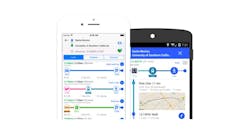Go LA App Provides Mobile Access to All Forms of Transportation
There’s a new transportation app in town, and it’s taking on the Los Angeles metro area, with its enormous traffic and commuting volumes.
The city of Los Angeles is introducing the Go LA app, powered by Xerox, a solution that integrates all the available methods of getting around the second largest metro area in the United States. Unlike other efforts to improve the daily commute, the Go LA app captures the universe of transportation options and computes the shortest, cheapest, and most sustainable way to get to your destination. The city of Los Angeles is piloting the app in partnership with Xerox to provide travelers with optimized transportation choices to simplify urban mobility.
"The Go LA app will help Angelenos get where they want to go by connecting smart technology with infrastructure," said Los Angeles Mayor Eric Garcetti. "Go LA gives users the opportunity to move around in smarter, faster, cheaper, and greener ways by linking them to all the transportation options available to them -- from freeways to Metro to bike routes -- while also providing the city with useful data to help us make policy decisions that benefit residents."
How Go LA works for residents and visitors
The app aggregates and calculates the time, cost, carbon footprint, and health benefits from walking, biking, driving your own car, parking, taking public transit, as well as the emerging private transportation options – such as Lyft, Zipcar, FlitWays and Uber – giving users a variety of ways to reach their destination. Discovering user needs for combining public and private transportation options, Xerox researchers designed and delivered this smart city solution.
“There are individual apps for public transit, car sharing and other transportation options but the Go LA app captures the array of options in a hyper-local way, mixing and matching both public and private transportation options,” said David Cummins, senior vice president, Mobility Solutions, Xerox. “Beyond the seamless travel experience for citizens, Go LA will help the city glean important information they can use to advance their transportation systems.”
The app takes an individual’s destination and desired arrival time, and calculates the different routes available, categorized by “sooner,” “cheaper,” and “greener.”
Details provided include length of trip, price, number of calories burned, and how much carbon dioxide is released into the air – allowing users to choose the best option to meet their needs. As the app learns more about its user’s individual travel preferences, it will eventually recommend and highlight personalized commuting options. Customers can also save trips they take often, like from home to work, in their “My Rides” area of the app.
Guidance for City Planners
The destination and preferred travel mode data is anonymously shared with the city to deliver insights on how people travel around the region. This information is useful as cities look to redesign and update the travel systems while optimizing capital spend.
“Our city has many centers. People are commuting in all directions at all times by many modes,” said Seleta Reynolds, general manager, Los Angeles Department of Transportation. “Xerox’s work could help us learn where to improve infrastructure for people who walk, roll, bike, take transit and drive– it’s invaluable insight to help make Los Angeles more livable and enjoyable.”
What’s coming next?
Xerox is working with its partners to integrate booking and payments into the app so users can coordinate their entire trip with a single click of a button. Future versions of the app will also include ridesharing so that users can carpool with people traveling in the same direction, as well as destination parking information. After enough data is collected, users will also be able to create a profile where they can set goals related to their personal fitness, financials and time, and track them within the app.
The Go LA app is now available for iOS and Android systems in the Apple and Google Play stores at www.golaapp.com. A customized version of this app will be rolled out by the City of Denver in February 2016.



